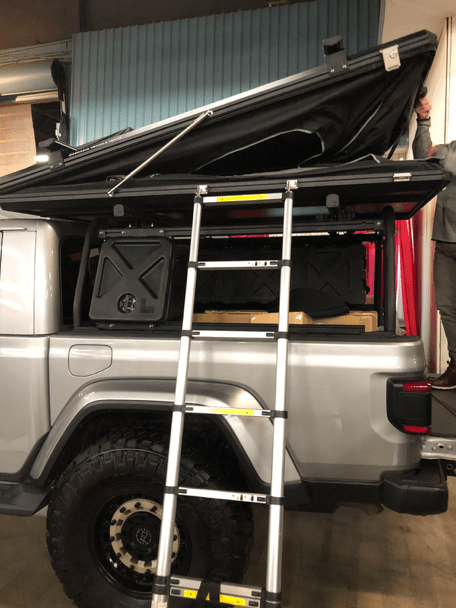Hauling a roof top tent (RTT) will definitely take a toll on your gas mileage. You won’t be able to find one solution to offset it. There are many factors that come into play with RTTs lowering your fuel economy. This article will detail the various steps you can take to try and improve your gas mileage while using a RTT.
To reduce the drag produced by a roof top tent you can buy a hardshell style tent, equip an aerodynamic roof rack, install a fairing, and position it properly on your vehicle.
I am not an expert in aerospace, just another camper looking to make this information accessible and easier to digest. With that said, I hope you find the many tips of use to your current situation!
Why does a roof top tent affect fuel economy?
So much as putting a roof rack on your vehicle will affect your gas mileage, even an empty one.
Adding a RTT gives your vehicle a boxier shape. This restricts airflow that would otherwise run smoothly over your vehicle. The simplest and most obvious solution to remedy this is to take your tent down during the off season. At least this way you won’t have to take it on and off multiple times, just when you plan to use it during your camping season.
Hardtop vs Soft shell roof top tent affect on gas mileage
Soft shell foldable tents look like a brick sitting on top of your roof. Due to their design and height when folded up, you would expect to see a bigger drop in your fuel economy with these models. I think soft shells are great and serve many purposes, but as far as gas mileage goes they aren’t the friendliest.
On the other hand, hardtop RTTs have sleeker designs featuring a slimmer profile. This design will have less drag and have a far less impact on your fuel economy. If you’re really concerned about losing gas mileage because of your RTT, then a hardtop is best for you. They will typically run you more money because of the cost of materials to build them.
The picture below features a Cascadia Vehicle Tent which I saw at a local expo in the NorthWest. This picture shows how slim these hardtops can be.

Where you position the roof top tent can affect gas mileage
The placement of your tent can affect your gas mileage. Ideally, you should aim to have your tent as low to your roof or truck bed as possible. This is something you would have to give some thought when buying a rack. You can check the specs and see how high the rack and tent would sit. There are low profile racks that look nice and sleek. Be aware that these can sometimes make it difficult to get your hands under the rack to mount your tent.
There is a good chance you’re reading this and already have a rack and RTT. If this is the case, aim to distribute the weight of your tent between the two axles of your vehicle. You want to position your tent as close to the center as possible. You likely won’t be able to position it perfectly, but moving your tent to the front most position should be good enough. You can then load gear behind the tent which will result in less overall drag.
I have listed all of my favorite and must-have roof top tent essentials here if you’re interested in shopping around!
I would like to add that not every vehicle is similar in its design and distribution. You may have made some aftermarket changes that affect the weight distribution too. You can look up the specific make and model of your vehicle to figure out the accurate position to mount your tent. At the end of the day, you know how your vehicle drives better than anyone and it’s your call to make!
Not only can this simple change be forgiving on your gas tank, but it also prevents wear and tear on your drive train. Next time you mount your tent onto the roof rack follow these simple tips and you could see or feel a difference on the road.
Certain roof racks are better for reducing drag
The same principal applies to these rack as your standard roof rack. The lower you can get your tent to sit and be shielded by the natural design of the vehicle, the less drag will be produced.
You may use your truck as a daily driver and have the need for a functional truck bed that you can load things into easily. If that’s the case, I would recommend sticking with a rack that sits much higher and has a better clearing. It won’t be as fuel friendly, but it will suit your lifestyle best!
This rack sits fairly low and allows for about half the tent to be shielded by the roof. In a perfect world you would want the tent to sit flush, but that’s easier said than done. Any amount of the tent you can cover behind your cab is an added benefit.

Awnings & Misc Gear that can improve fuel efficiency while using a roof top tent
Other attachments like awnings will have a small effect on your fuel economy because of their compact size. If you’re carrying extra gear on your roof and have room behind the tent, try to load your gear there and that will likely help with drag too.
Add a fairing to reduce the drag created by your roof top tent
You’ve probably seen a fairing on a semi-truck and never noticed it. Their sole purpose is to help push the wind up and reduce drag. The taller the fairing the better, especially if you have a foldable tent.
You can buy them at Amazon, REI, and many other outdoor retailers. Fairings aren’t very expensive, look good, and will positively affect your gas mileage. I would recommend going with a Yakima or Thule fairing!
Below is an Amazon Affiliate picture just to provide a visual. The link will take you to Amazon for more information.

I have an additional link for you DIY rebels. This gentlemen built a really good looking and tall fairing to completely cover his RTT. Just scroll through the thread and you’ll see what I am referring to.
https://www.tacomaworld.com/threads/improving-mpg-with-a-rtt.413220/
How you drive with a roof top tent determines fuel efficiency
Are you a driver that prefers to drive in the “fast lane”? Or do you prefer to get to your destination at your own pace?
Believe it or not this is one of the biggest contributors to controlling fuel efficiency. At higher speeds your vehicle will create more drag. The more drag you have directly correlates with less gas mileage.
According to a test done by tflcar.com, adding a RTT to a vehicle on the same route dropped the fuel economy by 17%. To say that is substantial is an understatement..
You’ll notice as you hit higher speeds you will swerve in the wind. If you’re not in any rush and want to save a little money on gas, try driving a bit slower on the freeway. It will make a difference and be safer as well!
Each vehicle’s fuel economy will be affected differently by a roof top tent
A vehicle that can reach 40 MPG will see a bigger decline in fuel efficiency in comparison to one that gets 20 MPG.
The hypothetical 40 MPG vehicle is likely lighter and has a solid aerodynamic design. When you add a heavy RTT onto that, it will have a greater effect on the MPG.
Lastly, the torque of your vehicle matters too. This is why the 20 MPG vehicle would likely perform better with a RTT because of its engine. In theory, more torque from an engine means it is easier to get the car moving, which should use less fuel. So a big truck with a beefy diesel engine should see less of a falloff in fuel economy compared to a V6 engine.
Weather Conditions can effect how your car handles with a roof top tent attached
We all wish we could control the weather. But if it’s a bit windy, you’re not going to cancel your camping trip! However, you should expect to see a decent drop in your gas mileage. Wind simply creates more drag, slows you down, and in turn burns more fuel.
Conclusion
Now that you have many suggestions on how to mitigate your mileage loss and what can affect it, maybe you found a way to implement this to your current setup. If not, you can always control your style of driving and be aware of these tips for future purchases. As I said in the beginning, there’s not a one size fits all solution. But there are some small, and big, solutions to this common question.
I hope you found this article to be helpful and full of useful information, thank you for reading!
